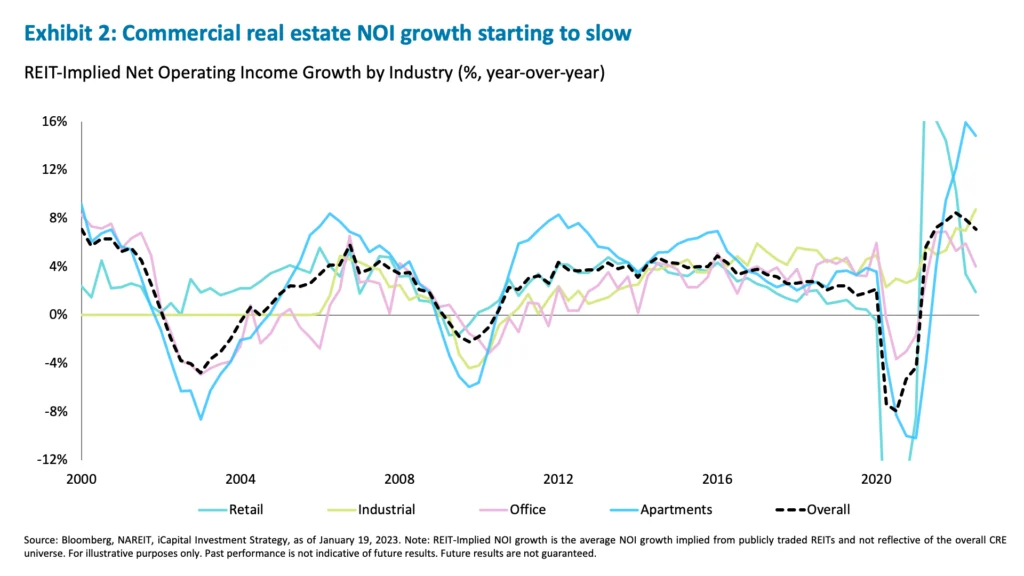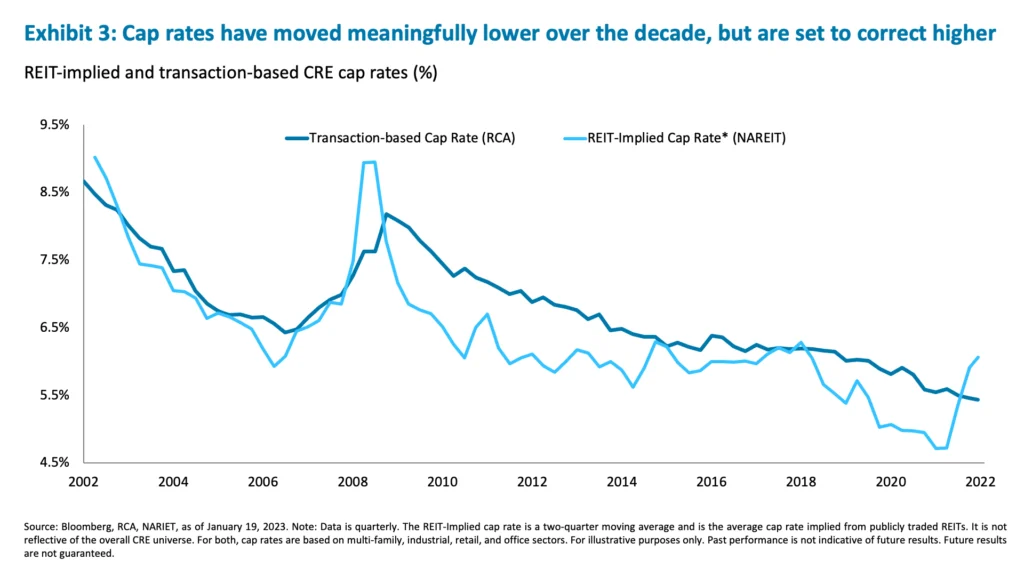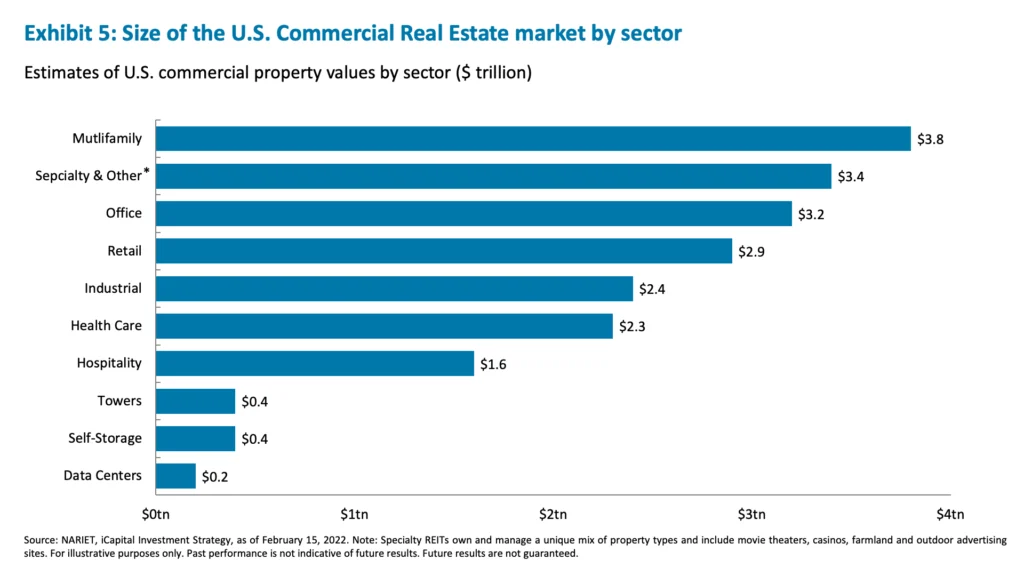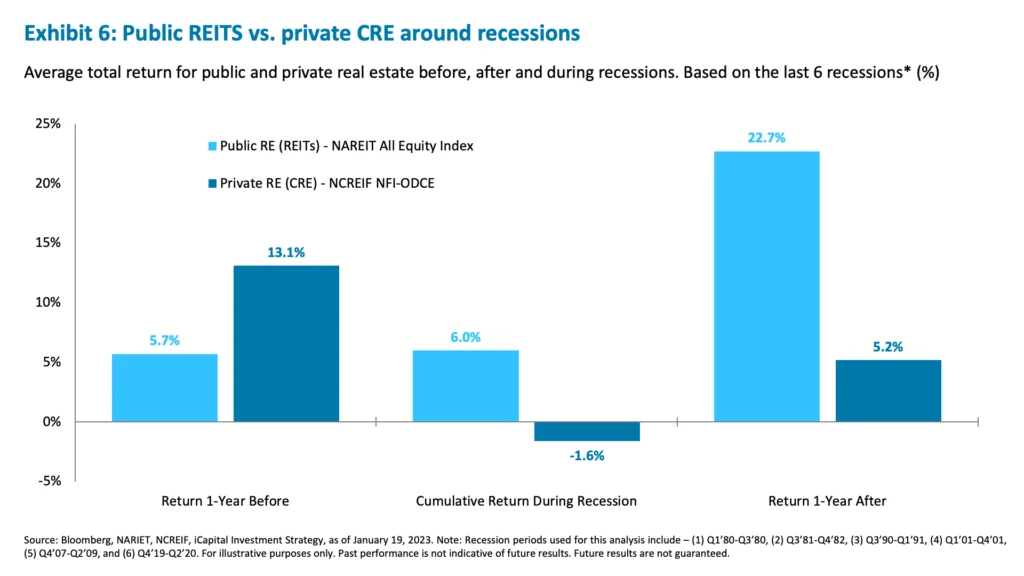For the better part of 2022, the broader Commercial Real Estate (CRE) market was able to effectively weather ongoing cyclical headwinds – rising interest rates, slowing economic outlook, slowing deal volumes – but now shows signs of near-term price depreciation across select sectors. Despite this, for the full year 2022, CRE, proxied by NCREIF National Property Index, delivered a healthy 5.5% return compared with a decline of 24.9% for publicly traded REITs and a loss of 16.1% for the traditional 60/40 portfolio of equities and bonds (Exhibit 1).1
Many investors are now concerned about emerging signs of price depreciation across select sectors. In fact, according to the appraisal-based Green Street Commercial Property Price Index, which tends to lead the NCREIF NPI Index by two to three quarters, property values have declined 8% in the last three months.2 This trend may continue, especially considering the changing macroeconomic backdrop, but it doesn’t change our view that private real estate belongs in a well-diversified portfolio. In this week’s commentary, we address the top questions investors are asking about CRE right now.
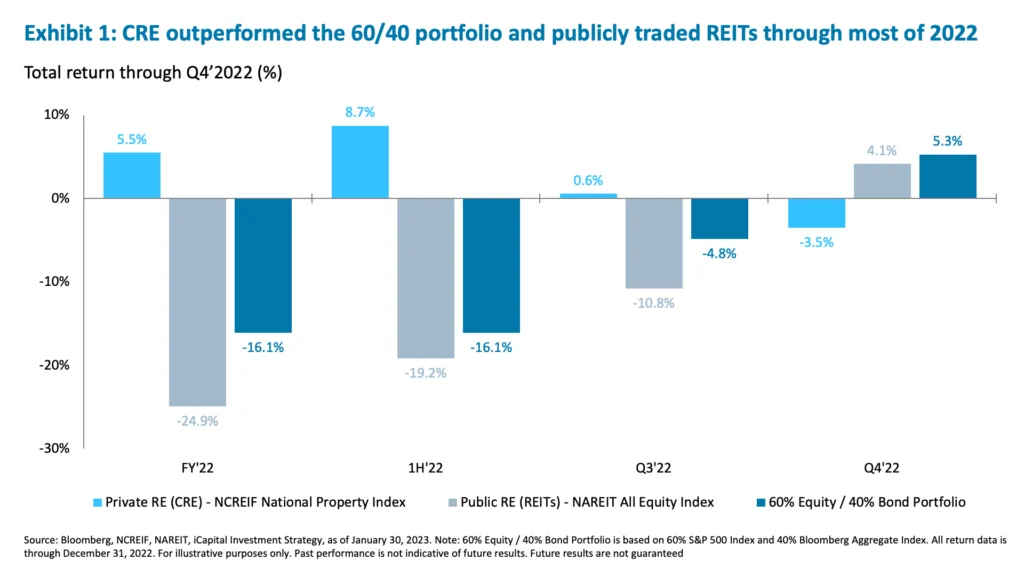
1. What is the outlook for the CRE industry and will 2023 be the year of further depreciation of CRE prices?
We do suspect some CRE depreciation could continue for several quarters, pressured by lower net operating income (NOI) growth and higher cap rates, but note that CRE has the potential for a turnaround sometime in mid-2023 as a recession/slowdown materializes and the Fed pauses.
In the back half of 2022, rising interest rates and recessionary fears put downside pressure on the CRE market. However, the Fed now appears to be on pace to finish its rate hiking cycle around the 5.0% mark – the fed funds rate is currently at 4.5% – by the March or May meeting of this year.3 At the same time, the market has now seemingly priced-in a sizable potential for a recession as evident through the recent declines in long-term yields.4 Still, while these sources of pressure have become baked-in over the near-term, two other forces are likely to act as a headwind to the industry and, in our view, could push CRE prices lower over the coming quarters: (1) lower market rents contributing to lower/negative NOI growth; and (2) higher cap rates.
Slowing NOI growth: Signs of slowing market rent growth has led to a decrease in NOI growth. Based on data implied from public REITs, overall year-over-year NOI growth is down from its prior record levels (Exhibit 2). Looking ahead, NOI growth is forecasted to slow further, falling from 8.2% in 2022 to 4.4% in 2023, with some significant variability across sectors.5 Private market data also suggests that NOI growth is already slowing and, in fact, turning negative quarter-over-quarter in some sectors, such as office and retail.6 That said, current projections do not model for a recession, and therefore, in the event one occurs, NOI growth would likely drift to the low-single digits or even negative.7
Reset in cap rates: Cap rates, or the expected rate of return on real estate investment properties, are low on an absolute and relative basis and will likely need to rise to compensate investors for a higher degree of risk associated with a worsening economic backdrop and recessionary fears.8 Over the past decade, cap rates, both transaction-based and REIT-implied, have largely moved one way – down. However, implied cap rates in publicly traded REITs have recently begun to correct and move higher, rising nearly 150bps to 6.1% as of the end of Q3’22 (Exhibit 3).9 But the transaction-based cap rates for private real estate have further room to correct higher, as the data is not yet showing an uptick in cap rates.10 As this plays out and prices likely correct, CRE assets should become relatively more attractive to investors again from the cap rate and price appreciation potential standpoint.
So, what? The question turns to when or how do we know that the CRE correction is complete. Much like for equities, a Fed pause or pivot to rate cuts after the onset of the recession/slowdown is the clue. And as we highlighted here, we expect the door might finally be open for a pivot around the June FOMC, but the pause should come before then, possibly as soon as this spring.
2. How will CRE be able to shoulder the burden of the cost of financing rising quickly and sharply?
The current rate environment is straining REIT and property cash flows, but an eventual reset lower in rates, lower leverage, and higher debt coverage ratios this time around should help.
The share of adjustable-rate CRE loans has increased from roughly 5% to 45% in the past decade and currently sits well above the long-term average of roughly 18%.11 The rate on an adjustable-rate CRE loan went from roughly 1% at the start of 2022 to roughly 5.5% at the end of September 2022.12 And if a previously issued fixed rate CRE loan had to be refinanced as it matured today, it too would be at a significantly higher rate.13 These financing costs are likely to be above cap rates for multifamily and industrial real estate, with only retail and office offering higher cap rates (and its own host of challenges). The sharp rise in costs is clearly worsening real estate economics, with 2023 earnings for public REITs projected to weaken when isolating the impact from rate rises alone.14 But there are several offsets.
First, while the Fed is expected to raise rates to 5%, it’s not expected to keep them there for too long. Looking out the next couple of years, the implied fed funds rate is expected to fall back to 3.25% by the end of 2024.15 So when large debt maturities come around in 2024, the cost to refinance may not be as high as it is today. Second, fundamentals remain strong, helping offset some of the worries of higher borrowing costs. The average loan-to-value ratio for debt-financed property is currently 57% today, down from 67% in 2007.16 Developers and property operators have been more conservative with leverage this time around, meaning the debt service ratios are also better. At current, coverage ratios stand at 2.5x compared with 1.4x in 2007.17 As a result, lower leverage and higher coverage ratios mean lenders are more insulated from property price and market rent declines and elevated defaults. Lastly, as we described above, it is our view that cap rates should move higher, so the relationship between the cost of financing and cap rates should normalize, even if we don’t expect it to revert to the ultra-attractive levels of the last 10 years.
3. With the risk-free rate on track to pay close to 5% in the coming months, how does CRE compete with that? Does CRE still make sense as a part of a diversified portfolio?
Despite cash yielding a historically competitive rate, the risk-free rate is likely to revert back to lower levels, possibly in the back half of 2023 or in 2024. However, for real estate, yields tend to be more stable and predictable in nature and tax treatment is more favorable.
For CRE, rents continue to be collected during uncertain times and income continues to get paid out. As a result, the income component of CRE returns does not generally fluctuate materially through varying parts of the economic cycle. In fact, income return for the broader CRE market has averaged roughly 4.5% annually over the past decade.18 That said, the rental income allows investors to ride out the uncertainty while still collecting a stable and predictable stream of cash flows.19 Compare this to cash where the yield is vulnerable to changes in the fed funds rate.
Looking ahead, while return from price appreciation is expected to be roughly flat to negative over the coming year, income return is still expected to be around 4.5% (Exhibit 4).20 And following market corrections, the potential for capital appreciation returns in CRE should improve. This should especially be the case this cycle as low vacancies, structural undersupply of housing, secular trends of onshoring, and the move to sustainability will all likely be long-term supportive factors for CRE pricing.
Additionally, investors are also offered favorable tax treatment whether investing in CRE via publicly traded REITs or non-traded REITs. For REITs, while not tax-free, they offer investors preferential tax treatment including a 20% deduction on the ordinary income portion of distributions.21 This can effectively reduce the tax rate for an individual in the highest tax bracket from a rate of 37% to 29.6%.22 Also, REITs offer the ability to characterize a portion of distributions as return on capital as opposed to ordinary income, due to depreciation and amortization factors. In doing this, return on capital distributions reduce the cost basis of the investment(s) in the year the distributions are received and allows it be tax deferred until redemption. When viewed through this lens, real estate – specifically REITs – can offer investors with a longer-term investment horizon an attractive taxable equivalent yield that is roughly 100-300bps above the pre-tax yield.23
4. Where are the best opportunities in CRE right now?
Based on recent conversations with various managers, areas of opportunity include real estate lending, secular growers, and the emerging dislocation between public REITs vs. private CRE.
Real estate lending: With banks pulling back from CRE loans as lending standards tighten, and securitization having slowed down markedly, new real estate projects are turning to alternative pools of capital such as private real estate funds. In fact, the investment environment for private real estate lending looks increasingly attractive when considering that roughly $400 to $450 billion of CRE loans will be maturing on an annual basis over the next couple of years.24 From an investor’s standpoint, an average, a mezzanine tranche CRE loan is a floating rate structure with a spread of 400-500bps over the Secured Overnight Financing Rate (SOFR), thereby yielding close to 10-11%.25
Secular growers: Secular growers in real estate, including life science, self-storage, and affordable housing, are alive and well. Drug developers are continually renting out more life science space. A structural shift to work-from-home polices and a greater shift to densely populated metro-areas has fueled the need for self-storage as people look to free-up and add space. Affordable housing is also emerging as a key sustainability theme. As a result, vacancy rates are low in these sectors and NOI growth is solid. For the self-storage sector, for example, NOI growth is expected to remain 180bps over the broader public REIT universe in 2023.26
Public REITs vs. private CRE: As we wrote above, there might still be scope for private CRE valuations to correct, however, the correction in public REITs was already notable last year – the iShares REITs ETF was down –27% through the end of the year compared to S&P 500 which finished the year lower by -19%.27 As a result, REITs now trade at a -8.6% discount to the underlying real estate net asset value (NAV) and at a valuation multiple which is line with the S&P 500, vs. a 17% premium at the start of 2022.28 At this point, we believe the sector valuations have appropriately adjusted for the increase in rates. And we also expect that the 10-year U.S. Treasury yield has peaked for this interest rate hiking cycle, easing pressure on the sector, which otherwise is still expected to deliver a 4.5% earnings growth for 2023 and offers investors a 3.9% current dividend yield.29
Finally, given the forward-looking discounting mechanism of the public markets, public CRE tends to discount recessionary fears prior to actual recessions occurring. Therefore, on average, it performs worse than private real estate in the lead up to a recession but outperforms during and 12-months after a recession (Exhibit 6).30 However, while public REITs look attractive in this light, private CRE still outperforms as a long-term investment. Private CRE has outperformed REITs on a 5-, 10-, and 15-year basis.31
1. Bloomberg, iCapital Investment Strategy, as of January 30, 2023.
2. Green Street, NCREIF, iCapital Investment Strategy, as of January 19, 2022.
3. Bloomberg, iCapital Investment Strategy, as of January 19, 2023.
4. Bloomberg, iCapital Investment Strategy, as of January 19, 2023.
5. Bloomberg, JPMorgan, as of December 15, 2022.
6. NCREIF, as of November 30, 2022.
7. Bloomberg, iCapital Investment Strategy, as of January 19, 2023.
8. Bloomberg, iCapital Investment Strategy, as of January 19, 2023. Note: higher cap rates indicate a higher level of risk
9. Bloomberg, iCapital Investment Strategy, as of January 19, 2023.
10. CBRE, as of November 2022.
11. Goldman Sachs, iCapital Investment Strategy, as of November 9, 2022.
12. Moody’s, JPMorgan, as of September 30, 2022. Note: rate on adjustable-rate loans is based on the Single Asset Single Borrower CMBS AAA Floating Rate 5yr Initial Rate.
13. Moody’s, Blomberg, as of January 19, 2023.
14. Source JPMorgan, as of October 13, 2022.
15. Bloomberg, iCapital Investment Strategy, as of January 19, 2023.
16. Bloomberg, Trepp, Goldman Sachs, as of December 9, 2022.
17. Bloomberg, Trepp, Goldman Sachs, as of December 9, 2022.
18. Bloomberg, NCREIF, iCapital Investment Strategy, as of January 19, 2023.
19. NCREIF, JPMorgan, iCapital Investment Strategy, as of January 19, 2023.
20. PREA, LaSalle Investment Management, iCapital Investment Strategy, as of December 29, 2022.
21. IRS, NAREIT, as of January 19, 2023. Note: Current federal tax provisions allow for a 20% deduction on pass-through income through the end of 2025.
22. IRS, NAREIT, iCapital Investment Strategy, as of January 19, 2023.
23. JLL, Nuveen, Investopedia, Bloomberg, as of January 19, 2023. Note: the spread over the pre-tax yield is generally 100 to 300 bps and assumes (1) a maximum federal tax rate of 37%, (2) the investor characterizes 25% to 100% of distributions as return on capital. Higher percentage of return on capital would correlate to a higher taxable equivalent yield.
24. Oaktree, Morgan Stanley, Federal Reserve Senior Loan Officers Survey, as of June 30, 2020. Note: CRE loans include CMBS, Banks, Life Companies, and etc.
25. Oaktree, as of June 30, 2022.
26. JPMorgan, as of December 15, 2022.
27. Bloomberg, iCapital Investment Strategy, as of January 19, 2023.
28. JPMorgan, as of December 16, 2022
29. JPMorgan, as of December 16, 2022
30. Bloomberg, NAREIT, NCREIF, iCapital Investment Strategy, as of January 19, 2023.
31. Bloomberg, NAREIT, NCREIF, iCapital Investment Strategy, as of January 19, 2023.
IMPORTANT INFORMATION
The material herein has been provided to you for informational purposes only by iCapital, Inc. (“iCapital”). This material is the property of iCapital and may not be shared without the written permission of iCapital. No part of this material may be reproduced in any form, or referred to in any other publication, without express written permission of iCapital.
This material is provided for informational purposes only and is not intended as, and may not be relied on in any manner as, legal, tax or investment advice, a recommendation, or as an offer to sell, a solicitation of an offer to purchase or a recommendation of any interest in any fund or security. You should consult your personal accounting, tax and legal advisors to understand the implications of any investment specific to your personal financial situation. This material does not intend to address the financial objectives, situation or specific needs of any individual investor. Alternative investments are complex, speculative investment vehicles and are not suitable for all investors.
The information contained herein is an opinion only, as of the date indicated, and should not be relied upon as the only important information available. Any prediction, projection or forecast on the economy, stock market, bond market or the economic trends of the markets is not necessarily indicative of the future or likely performance. The information contained herein is subject to change, incomplete, and may include information and/or data obtained from third party sources that iCapital believes, but does not guarantee, to be accurate. iCapital considers this third-party data reliable, but does not represent that it is accurate, complete and/or up to date, and it should not be relied on as such. iCapital makes no representation as to the accuracy or completeness of this material and accepts no liability for losses arising from the use of the material presented. No representation or warranty is made by iCapital as to the reasonableness or completeness of such forward-looking statements or to any other financial information contained herein.
Securities products and services are offered by iCapital Markets, an SEC-registered broker-dealer, member FINRA and SIPC, and an affiliate of iCapital, Inc. and Institutional Capital Network, Inc. These registrations and memberships in no way imply that the SEC, FINRA, or SIPC have endorsed any of the entities, products, or services discussed herein. Annuities and insurance services are provided by iCapital Annuities and Insurance Services LLC, an affiliate of iCapital, Inc. “iCapital” and “iCapital Network” are registered trademarks of Institutional Capital Network, Inc. Additional information is available upon request.
© 2023 Institutional Capital Network, Inc. All Rights Reserved.



